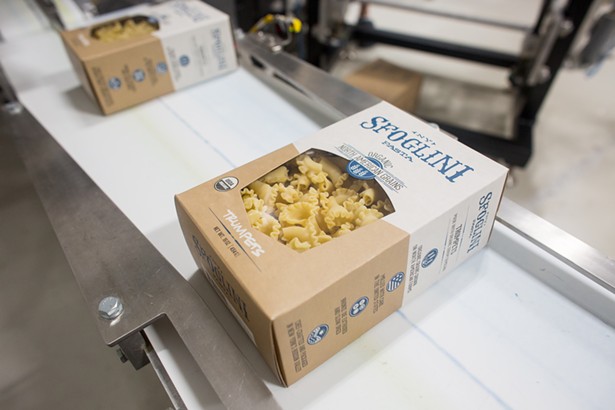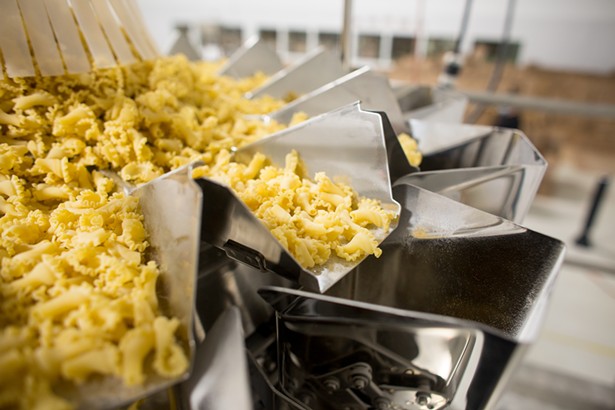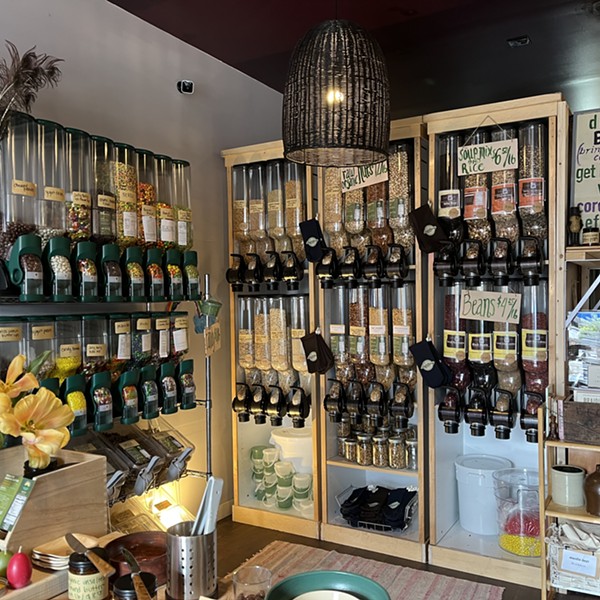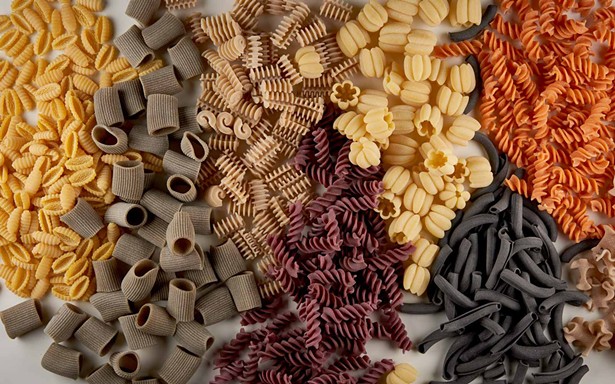
For devotees of the local food movement, dried pasta has long been thought of as a last resort—relegated to the back of the pantry in favor of its showier cousin fresh pasta. While there’s a lot to be said for the “fresh-is-best” mentality, ultimately, a lot of this ill will can be traced back to the historically dismal state of the grocery store pasta aisle, with plastic packaging boasting dubious qualities like “enriched wheat.”
Even in the hands of the culinarily gifted, a box of mass-produced spaghetti, penne, or rigatoni too often produces a lackluster pile of noodles—devoid of the toothsome texture and delicately nutty flavor that has made dried pasta, or pasta secca as it’s known in Italy, a lovable workhorse of the Mediterranean larder for centuries. Until relatively recently, artisanal food lovers had almost no options for sourcing good, domestically made, dried pasta. Instead, they had to make pilgrimages to natural foods stores or gourmet shops just to hunt down bags of the imported stuff from a top-shelf Italian producer.
Step into many of the same shops known for selling high-quality provisions throughout the Hudson Valley today, however, and you’ll likely find sturdy, brown-and-white boxes of Coxsackie-made Sfoglini pasta (pronounced sfo-lee-nee) sitting right next to those highfalutin imports.
A Recipe for Success
Sfoglini was founded in Brooklyn in 2012 by Scott Ketchum and Steve Gonzalez. Ketchum was a creative director and graphic designer specializing in brand development who had 18 years of experience working in New York and San Francisco and had studied brewing and management at the Siebel Institute in Chicago. The pasta expertise came from Gonzalez, a chef who had spent much of his 14-year-career immersed in the art of pasta making at acclaimed restaurants throughout Western Europe and the US. (His resume includes time at the three-Michelin-starred El Raco de Can Fabes in Sant Celoni, Spain, and beloved New York City spots such as Hearth, Roberta’s, and Frankies Spuntino.)

“There was really nothing going on in the pasta section at that time,” says Ketchum. “New York has this great history of Italian immigrants starting food companies, but they all moved out of Brooklyn at some point. We wanted to prove you could make a great pasta here in New York." So the two packed up what pasta-making equipment they had and moved into a rented space in the former Pfizer building in Williamsburg, which was already home to a handful of other small food companies. “We started in one old laboratory room and added space as we went along,” Ketchum says. “It took a lot of trial and error and feedback from customers to hone our process.”
Ketchum and Gonzalez started out selling fresh pasta to restaurants, but over time, it was Sfoglini’s dried pasta that proved to be a winning proposition. “There were the premium Italian brands who took great care with their dried pastas, using bronze dies and slow-drying, but it was not done much at all here,” says Ketchum. “We were really a catalyst for reviving pasta making in the US.”
The Bronze Age of Dried Pasta
The major thing that sets Sfoglini’s dried pasta apart from mainstream brands is its adherence to old-world techniques. Ketchum and Gonzalez worked with a 100-year-old, family-owned manufacturer in Brooklyn and another company in Boston to custom make their traditional bronze dies and plates.
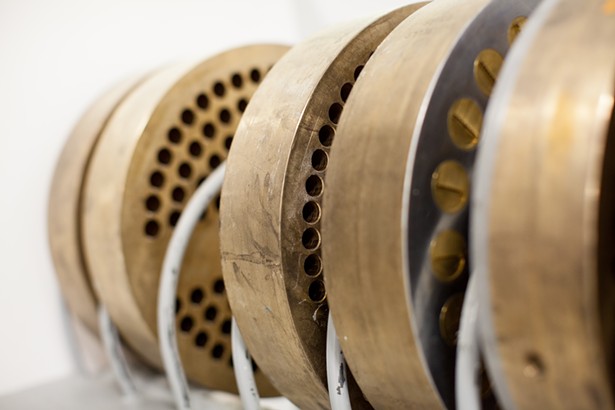
Most grocery store dried pasta, on the other hand, is made using Teflon-coated dies. Teflon’s appeal is its cost-effectiveness—it doesn’t expand and break down over time like bronze does—but it also results in a smoother surface that causes sauce to slide right off the pasta and onto your plate.
Additionally, in keeping with artisanal Italian methods, Sfoglini’s pastas are slow-dried for 10 days at a low temperature, which helps preserve both flavor and nutrients.
Coffey has featured the pasta in dishes such as reginetti with milk-braised suckling pig ragu, and his personal favorite, spaccatelli with duck ragu, which the chef makes with Sfoglini's organic semolina spaccatelli paired with duck liver, duck leg, soffrito, and Italian sausage. "The spaccatelli is perfect for picking up the meat and sauce, and provides a nice chewy texture," Coffey says. "The pasta really shines, because I don't have to use a lot of sauce, just enough to coat it."
How the Pasta Aisle Got Its Grooves Back
Today, Sfoglini makes dozens of varieties of pasta in an array of long-lost Italian shapes and adventurous flavors, whose whimsical grooves are made for holding hearty sauces. “It was part of our mission to bring back excitement and innovation to the pasta section,” says Ketchum. “We’ve helped reintroduce shapes that had fallen out of fashion.”
In addition to its classic organic semolina flour-only pastas, there’s frilly edged trumpets made with porcini mushroom purée, furled rolls of spaccatelli turned jet black with cuttlefish ink, and a hearty macaroni made with einkorn flour. Beginning next month, a pasta made with Oakland-based Diaspora Co.’s single-origin turmeric will be available for purchase online.
It’s not just the company’s riffs on old-school shapes that have been making waves. Last year, after almost three years of product development, Sfoglini helped introduce an entirely new pasta shape to the world. Cascatelli, the Italian word for “waterfalls,” was created by Dan Pashman, host of the James Beard-award-winning podcast “The Sporkful,” in partnership with the pasta maker.
The new pasta underwent a rigorous testing phase and three variations in length and diameter to achieve the perfect trifecta that Pashman refers to as “sauceability,” “forkability,” and “toothsinkability.” The final offering resembles something like a pool ladder with a deep groove down the center and wavy ruffles on either side. Sfoglini’s first 4,000-pound run sold out in two hours. Chefs and critics alike raved, and the shape even snagged a spot on Time’s 100 Best Inventions of 2021.
Pastaheads can get the jump on new and special edition varieties by signing up for Sfoglini’s pasta of the month club ($65 for three months, $120 for six), which includes a box each of its specialty pasta (think those adventurous flavors) and signature organic semolina pasta, along with recipes and pairing suggestions from Gonzalez. According to Ketchum, the preferences of its subscribers even help steer the company’s decisions about what products to grow and which to cull.
From Brooklyn to the Hudson Valley
A few years after Sfoglini’s founding, the pasta company had become a prominent presence in the New York City food scene, thanks to mom-and-pop shops like Bedford Cheese that began carrying its products. And through its partnership with the New York City Greenmarket Grain Program, a project to establish a market for Northeast-grown and -milled grains, market-goers were introduced to the brand through its line of pastas that featured lesser known ancient grains such as einkorn, emmer, and spelt.
“We were steadily growing year over year until about 2016,” says Ketchum. “The thing holding us back was that we couldn’t increase our growth with our existing capacity.” So the company began looking for new production space where it could scale operations in support of a plan to distribute its pasta more widely.
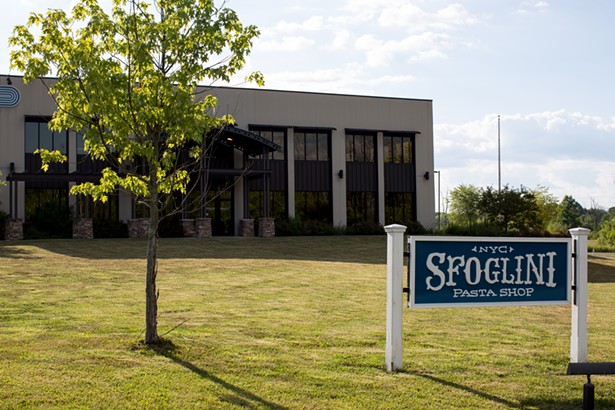
After the Coxsackie location became operational in July 2018, daily production increased six times over—from one to six thousand pounds of pasta a day.
The move to the Hudson Valley also added jobs, increasing the size of the team to 20. Most of the original staff, including Ketchum and Gonzalez, have relocated upstate full-time. “We’re always looking for people interested in learning about pasta production,” says Ketchum. “We want to hire as local as possible and support the community here.”
After four years and the recent addition of extra drying capacity, the new facility is finally closing in on maxing out its production. Roughly 8,000 pounds of pasta are made at the Coxsackie facility per day, and the company currently estimates that it will make nearly two million pounds this year. “We’re making the same great pasta we always have,” says Ketchum. “Now we can show people what American pasta makers are really capable of.”
Sfoglini pasta is available at gourmet shops and natural food markets across the region and at Sfoglini.com.







